Cross-Selectivity Enhancement of Poly(vinylidene fluoride-hexafluoropropylene)-Based Sensor Arrays for Detecting Acetone and Ethanol
Abstract
:1. Introduction
2. Materials and Methods
2.1. Method I
2.1.1. Addition of a PEO Layer on the Film
2.1.2. IR Treatment of the Film
2.2. Method II
2.2.1. Addition of DEC to the Film
2.2.2. Addition of PEO and DEC to the Film
2.3. Material Characterization
2.4. Sensor Experimental Set-Up
3. Material Characterization Results and Discussion
3.1. FTIR Analysis of IR Treatment and DEC Addition
3.1.1. FTIR Analysis of PVDF-HFP and PVDF-HFP/CB
3.1.2. FTIR Analysis Post IR Treatment
3.1.3. FTIR Analysis Post Addition of DEC
3.2. XRD Analysis
3.3. SEM Analysis
4. Sensor Results and Discussion
4.1. Method I
4.1.1. Addition of a PEO Layer on the Film
4.1.2. IR Treatment
4.2. Method II
4.3. Sensor Degradation
5. Conclusions
Acknowledgments
Author Contributions
Conflicts of Interest
References
- Kunstmann-Olsen, C.; Belić, D.; Bradley, D.F.; Grzelczak, M.P.; Brust, M. Humidity-dependent reversible transitions in gold nanoparticle superlattices. Chem. Mater. 2016, 28, 2970–2980. [Google Scholar] [CrossRef]
- Daneshkhah, A.; Shrestha, S.; Agarwal, M.; Varahramyan, K. Poly(vinylidene fluoride-hexafluoropropylene) composite sensors for volatile organic compounds detection in breath. Sens. Actuators B Chem. 2015, 221, 635–643. [Google Scholar] [CrossRef]
- Agarwal, M.; Balachandran, M.D.; Shrestha, S.; Varahramyan, K. SnO2 nanoparticle-based passive capacitive sensor for ethylene detection. J. Nanomater. 2012, 2012, 145406. [Google Scholar] [CrossRef]
- Meng, F.-L.; Guo, Z.; Huang, X.-J. Graphene-based hybrids for chemiresistive gas sensors. TrAC Trends Anal. Chem. 2015, 68, 37–47. [Google Scholar] [CrossRef]
- Cao, Q.; Rogers, J.A. Ultrathin films of single-walled carbon nanotubes for electronics and sensors: A review of fundamental and applied aspects. Adv. Mater. 2009, 21, 29–53. [Google Scholar] [CrossRef]
- Sinha, N.; Ma, J.; Yeow, J.T.W. Carbon nanotube-based sensors. J. Nanosci. Nanotechnol. 2006, 6, 573–590. [Google Scholar] [CrossRef] [PubMed]
- Yoon, H.J.; Jun, D.H.; Yang, J.H.; Zhou, Z.; Yang, S.S.; Cheng, M.M.-C. Carbon dioxide gas sensor using a graphene sheet. Sens. Actuators B Chem. 2011, 157, 310–313. [Google Scholar] [CrossRef]
- Lin, Z.D.; Young, S.J.; Chang, S.J. CO2 gas sensors based on carbon nanotube thin films using a simple transfer method on flexible substrate. IEEE Sens. J. 2015, 15, 7017–7020. [Google Scholar] [CrossRef]
- Wang, L.; Shi, X.; Kariuki, N.N.; Schadt, M.; Wang, G.R.; Rendeng, Q.; Choi, J.; Luo, J.; Lu, S.; Zhong, C.-J. Array of molecularly mediated thin film assemblies of nanoparticles: Correlation of vapor sensing with interparticle spatial properties. J. Am. Chem. Soc. 2007, 129, 2161–2170. [Google Scholar] [CrossRef] [PubMed]
- Huang, J.; Wan, Q. Gas sensors based on semiconducting metal oxide one-dimensional nanostructures. ResearchGate 2009, 9, 9903–9924. [Google Scholar] [CrossRef] [PubMed]
- Fine, G.F.; Cavanagh, L.M.; Afonja, A.; Binions, R. Metal oxide semi-conductor gas sensors in environmental monitoring. Sensors 2010, 10, 5469–5502. [Google Scholar] [CrossRef] [PubMed]
- Cooper, J.S.; Raguse, B.; Chow, E.; Hubble, L.; Müller, K.-H.; Wieczorek, L. Gold nanoparticle chemiresistor sensor array that differentiates between hydrocarbon fuels dissolved in artificial seawater. Anal. Chem. 2010, 82, 3788–3795. [Google Scholar] [CrossRef] [PubMed]
- Garg, N.; Mohanty, A.; Lazarus, N.; Schultz, L.; Rozzi, T.R.; Santhanam, S.; Weiss, L.; Snyder, J.L.; Fedder, G.K.; Jin, R. Robust gold nanoparticles stabilized by trithiol for application in chemiresistive sensors. Nanotechnology 2010, 21, 405501. [Google Scholar] [CrossRef] [PubMed]
- Song, E.; Choi, J.-W. Conducting polyaniline nanowire and its applications in chemiresistive sensing. Nanomaterials 2013, 3, 498–523. [Google Scholar] [CrossRef]
- Marchesi, L.F.Q.P.; Simões, F.R.; Pocrifka, L.A.; Pereira, E.C. Investigation of polypyrrole degradation using electrochemical impedance spectroscopy. J. Phys. Chem. B 2011, 115, 9570–9575. [Google Scholar] [CrossRef] [PubMed]
- Kim, Y.S.; Ha, S.-C.; Yang, Y.; Kim, Y.J.; Cho, S.M.; Yang, H.; Kim, Y.T. Portable electronic nose system based on the carbon black-polymer composite sensor array. Sens. Actuators B Chem. 2005, 108, 285–291. [Google Scholar] [CrossRef]
- Ashwini, N.; Mallya, R.K. Conducting polymer-carbon black nanocomposite sensor for volatile organic compounds and correlating sensor response by molecular dynamics. Sens. Actuators B Chem. 2014, 201, 308–320. [Google Scholar]
- Chatterjee, S.; Castro, M.; Feller, J.F. An e-nose made of carbon nanotube based quantum resistive sensors for the detection of eighteen polar/nonpolar VOC biomarkers of lung cancer. J. Mater. Chem. B 2013, 1, 4563–4575. [Google Scholar] [CrossRef]
- Lei, H.; Pitt, W.G.; McGrath, L.K.; Ho, C.K. Modeling carbon-black/polymer composite sensors. Sens. Actuators B Chem. 2007, 125, 396–407. [Google Scholar] [CrossRef] [PubMed]
- Xu, H.P.; Wu, Y.H.; Yang, D.D.; Wang, J.R.; Xie, Q.H. Study on theories and influence factors of PTC property in polymer-based conductive composites. Adv. Mater. Sci. 2011, 27, 173–183. [Google Scholar]
- Gurarslan, A.; Yu, Y.; Su, L.; Yu, Y.; Suarez, F.; Yao, S.; Zhu, Y.; Ozturk, M.; Zhang, Y.; Cao, L. Surface-energy-assisted perfect transfer of centimeter-scale monolayer and few-layer MoS2 films onto arbitrary substrates. ACS Nano 2014, 8, 11522–11528. [Google Scholar] [CrossRef] [PubMed]
- Salvatore, G.A.; Münzenrieder, N.; Barraud, C.; Petti, L.; Zysset, C.; Büthe, L.; Ensslin, K.; Tröster, G. Fabrication and transfer of flexible few-layers MoS2 thin film transistors to any arbitrary substrate. ACS Nano 2013, 7, 8809–8815. [Google Scholar] [CrossRef] [PubMed]
- Martins, P.; Lopes, A.C.; Lanceros-Mendez, S. Electroactive phases of poly(vinylidene fluoride): Determination, processing and applications. Prog. Polym. Sci. 2014, 39, 683–706. [Google Scholar] [CrossRef]
- Lonergan, M.C.; Severin, E.J.; Doleman, B.J.; Beaber, S.A.; Grubbs, R.H.; Lewis, N.S. Array-based vapor sensing using chemically sensitive, carbon black-polymer resistors. Chem. Mater. 1996, 8, 2298–2312. [Google Scholar] [CrossRef]
- Kumar, B.; Castro, M.; Feller, J.-F. Quantum resistive vapour sensors made of polymer coated carbon nanotubes random networks for biomarkers detection. Chem. Sens. 2013, 3, 20. [Google Scholar]
- Pandis, C.; Peoglos, V.; Kyritsis, A.; Pissis, P. Gas sensing properties of conductive polymer nanocomposites. Procedia Eng. 2011, 25, 243–246. [Google Scholar] [CrossRef]
- Tapnurat, M.; Choopun, S.; Gardchareon, A.; Singjai, P.; Mangkorntong, P.; Mangkorntong, N. Thick film of carbon nanotube composite for ethanol sensor. J. Spec. Issue Nanotechnol. 2005, 4, 21–25. [Google Scholar]
- Lai, Y.-T.; Kuo, J.-C.; Yang, Y.-J. A novel gas sensor using polymer-dispersed liquid crystal doped with carbon nanotubes. Sens. Actuators A Phys. 2013, 215, 83–88. [Google Scholar] [CrossRef]
- Robinson, J.A.; Snow, E.S.; Bǎdescu, Ş.C.; Reinecke, T.L.; Perkins, F.K. Role of defects in single-walled carbon nanotube chemical sensors. Nano Lett. 2006, 6, 1747–1751. [Google Scholar] [CrossRef] [PubMed]
- Olejnik, R.; Slobodian, P.; Riha, P.; Saha, P. Selectivity of multi-wall carbon nanotube network sensoric units to ethanol vapors achieved by carbon nanotube oxidation. J. Mater. Sci. Res. 2012, 1, 101–106. [Google Scholar] [CrossRef]
- Sin, M.L.Y.; Chow, G.C.T.; Li, W.J.; Leong, P.; Wong, M.K.; Wong, K.W.; Lee, T. Chemically functionalized multi-walled carbon nanotube sensors for ultra-low-power alcohol vapor detection. In Proceedings of the Sixth IEEE Conference on Nanotechnology, Cincinnati, OH, USA, 17–20 July 2006; Volume 2, pp. 461–464.
- Fu, K.; Chen, S.; Zhao, J.; Willis, B.G. Dielectrophoretic assembly of gold nanoparticles in nanoscale junctions for rapid, miniature chemiresistor vapor sensors. ACS Sens. 2016, 1, 444–450. [Google Scholar] [CrossRef]
- Chaing, H.-S. Thermodynamics of Benzene Sorption in Polyethylene Oxide. Ph.D. Thesis, Texas Tech University, Lubbock, TX, USA, 1977. [Google Scholar]
- Xie, H.; Yang, Q.; Sun, X.; Yang, J.; Huang, Y. Gas sensor arrays based on polymer-carbon black to detect organic vapors at low concentration. Sens. Actuators B Chem. 2006, 113, 887–891. [Google Scholar] [CrossRef]
- Marra, J.; Hair, M.L. Interactions between two adsorbed layers of poly(ethylene oxide)/polystyrene diblock copolymers in heptane—Toluene mixtures. Colloids Surf. 1988, 34, 215–226. [Google Scholar] [CrossRef]
- Aliahmad, N.; Shrestha, S.; Varahramyan, K.; Agarwal, M. Poly(vinylidene fluoride-hexafluoropropylene) polymer electrolyte for paper-based and flexible battery applications. AIP Adv. 2016, 6, 065206. [Google Scholar] [CrossRef]
- Shimizu, H.; Arioka, Y.; Ogawa, M.; Wada, R.; Okabe, M. Sol-gel transitions of poly(vinylidene fluoride) in organic solvents containing LiBF4. Polym. J. 2011, 43, 540–544. [Google Scholar] [CrossRef]
- Reiteration of Existing OSHA Policy on Indoor Air Quality: Office Temperature/Humidity and Environmental Tobacco Smoke. Occupational Safety and Health Administration. Available online: https://www.osha.gov/pls/oshaweb/owadisp.show_document?p_table=INTERPRETATIONS&p_id=24602 (accessed on 9 November 2016).
- Jayasuriya, A.C.; Schirokauer, A.; Scheinbeim, J.I. Crystal-structure dependence of electroactive properties in differently prepared poly(vinylidene fluoride/hexafluoropropylene) copolymer films. J. Polym. Sci. Part B Polym. Phys. 2001, 39, 2793–2799. [Google Scholar] [CrossRef]
- Srivastava, H.; Lade, H.; Paul, D.; Arthanareeswaran, G.; Kweon, J.H. Styrene-based copolymer for polymer membrane modifications. Appl. Sci. 2016, 6, 159. [Google Scholar] [CrossRef]
- Batth, A.; Mueller, A.; Rakesh, L.; Mellinger, A. Electrical properties of poly(vinylidene fluoride-hexafluoropropylene) (PVDF-HFP) blended with carbon nanotubes. In Proceedings of the 2012 Annual Report Conference on Electrical Insulation and Dielectric Phenomena (CEIDP), Montreal, QC, Canada, 14–17 October 2012; pp. 28–31.
- Saikia, D.; Kumar, A. Ionic conduction in P(VDF-HFP)/PVDF–(PC + DEC)–LiClO4 polymer gel electrolytes. Electrochim. Acta 2004, 49, 2581–2589. [Google Scholar] [CrossRef]
- Ataollahi, N.; Ahmad, A.; Hamzah, H.; Rahman, M.Y.A.; Mohamed, N.S. Ionic conductivity of PVDF-HFP/MG49 based solid polymer electrolyte. Adv. Mater. Res. 2012, 501, 29–33. [Google Scholar] [CrossRef]
- Sim, L.N.; Majid, S.R.; Arof, A.K. FTIR studies of PEMA/PVdF-HFP blend polymer electrolyte system incorporated with LiCF3SO3 salt. Vib. Spectrosc. 2012, 58, 57–66. [Google Scholar] [CrossRef]
- Zeng, Z.; Yu, D.; He, Z.; Liu, J.; Xiao, F.-X.; Zhang, Y.; Wang, R.; Bhattacharyya, D.; Tan, T.T.Y. Graphene oxide quantum dots covalently functionalized PVDF membrane with significantly-enhanced bactericidal and antibiofouling performances. Sci. Rep. 2016, 6, 20142. [Google Scholar] [CrossRef] [PubMed]
- Peng, G.; Zhao, X.; Zhan, Z.; Ci, S.; Wang, Q.; Liang, Y.; Zhao, M. New crystal structure and discharge efficiency of poly(vinylidene fluoride-hexafluoropropylene)/poly(methyl methacrylate) blend films. RSC Adv. 2014, 4, 16849–16854. [Google Scholar] [CrossRef]
- Bai, H.; Wang, X.; Zhou, Y.; Zhang, L. Preparation and characterization of poly(vinylidene fluoride) composite membranes blended with nano-crystalline cellulose. Prog. Nat. Sci. Mater. Int. 2012, 22, 250–257. [Google Scholar] [CrossRef]
- Rana, D.S.; Chaturvedi, D.K.; Quamara, J.K. Morphology, crystalline structure, and chemical properties of 100 MeV Ag-ion beam irradiated polyvinylidene fluoride (PVDF) thin film. J. Optoelectron. Adv. Mater. 2009, 11, 705–712. [Google Scholar]
- Silva, A.B.; Wisniewski, C.; Esteves, J.V.A.; Gregorio, R.G., Jr. Effect of drawing on the crystal-amorphous interphase, remanent polarization and dielectric properties of α-PVDF Films. Ferroelectrics 2011, 413, 220–230. [Google Scholar] [CrossRef]
- Svatos, A.; Attygalle, A.B. Characterization of vinyl-substituted, carbon-carbon double bonds by GC/FT-IR analysis. Anal. Chem. 1997, 69, 1827–1836. [Google Scholar] [CrossRef] [PubMed]
- Chen, M.; Zeng, H.; Larkum, A.W.D.; Cai, Z.-L. Raman properties of chlorophyll d, the major pigment of Acaryochloris marina: Studies using both Raman spectroscopy and density functional theory. Spectrochim. Acta A Mol. Biomol. Spectrosc. 2004, 60, 527–534. [Google Scholar] [CrossRef]
- Prasad, S.G.; De, A.; De, U. Structural and optical investigations of radiation damage in transparent PET Polymer films. Int. J. Spectrosc. 2011, 2011, 810936. [Google Scholar] [CrossRef]
- Vasundhara, K.; Mandal, B.P.; Tyagi, A.K. Enhancement of dielectric permittivity and ferroelectricity of a modified cobalt nanoparticle and polyvinylidene fluoride based composite. RSC Adv. 2015, 5, 8591–8597. [Google Scholar] [CrossRef]
- Nallasamy, P.; Mohan, S. Vibrational spectroscopic characterization of form II poly(vinylidene fluoride). Indian J. Pure Appl. Phys. IJPAP 2005, 43, 821–827. [Google Scholar]
- Daneshkhah, A.; Shrestha, S.; Agarwal, M.; Varahramyan, K. PPy/PMMA/PEG-based sensor for low-concentration acetone detection. In Proceedings of the SPIE 9107, Smart Biomedical and Physiological Sensor Technology XI, Baltimore, WD, USA, 7–9 May 2014; Volume 9107. ID 910712.
- Bai, H.; Shi, G. Gas Sensors Based on Conducting Polymers. Sensors 2007, 7, 267–307. [Google Scholar] [CrossRef]
- Prabakaran, K.; Mohanty, S.; Nayak, S.K. PEO/PVdF–HFP electrolytes for natural dye sensitized solar cell applications: Effect of modified nano-TiO2 on electrochemical and photovoltaic performance. J. Mater. Sci. Mater. Electron. 2015, 26, 3887–3897l. [Google Scholar] [CrossRef]
- Ho, D.L.; Hammouda, B.; Kline, S.R.; Chen, W.-R. Unusual phase behavior in mixtures of poly(ethylene oxide) and ethyl alcohol. J. Polym. Sci. Part B Polym. Phys. 2006, 44, 557–564. [Google Scholar] [CrossRef]
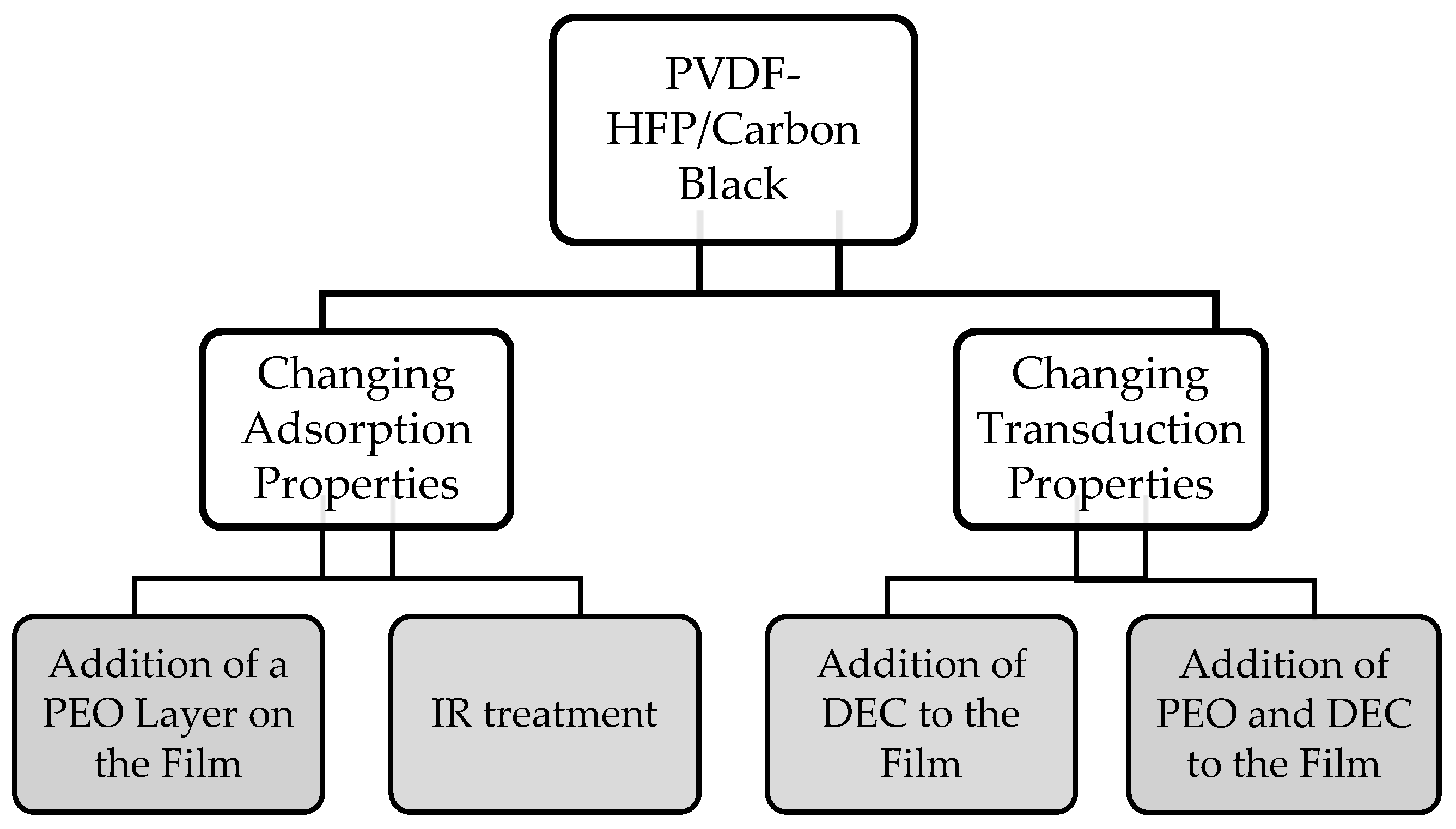

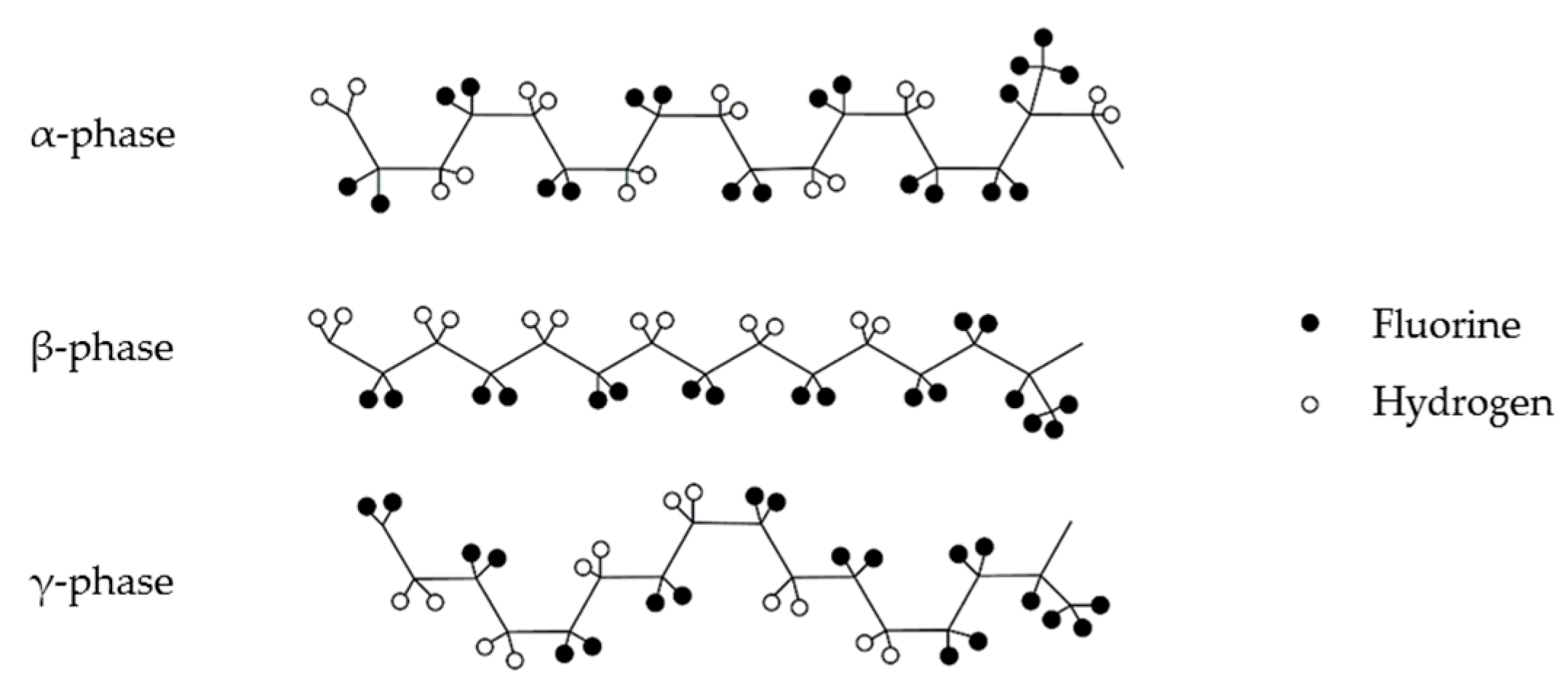
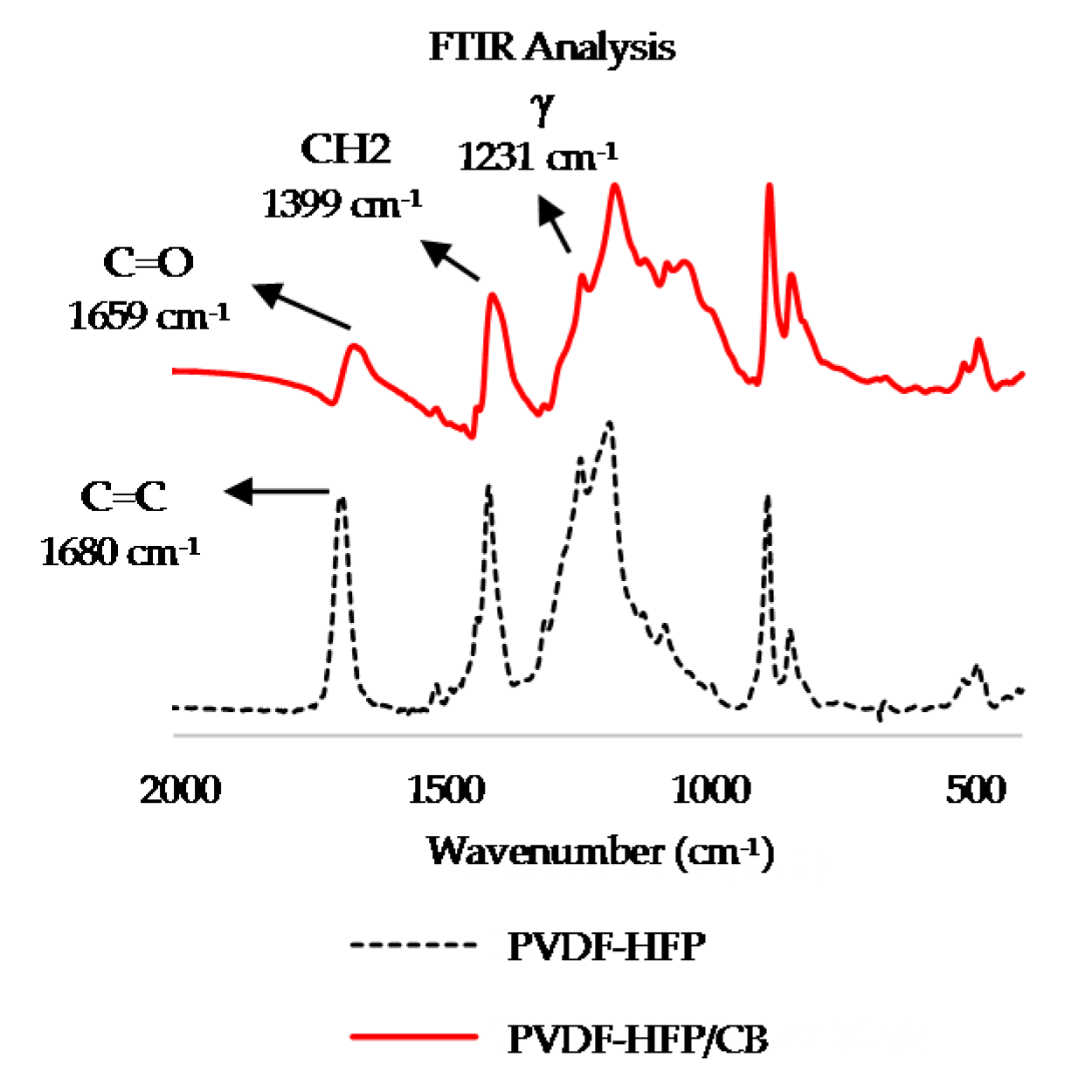
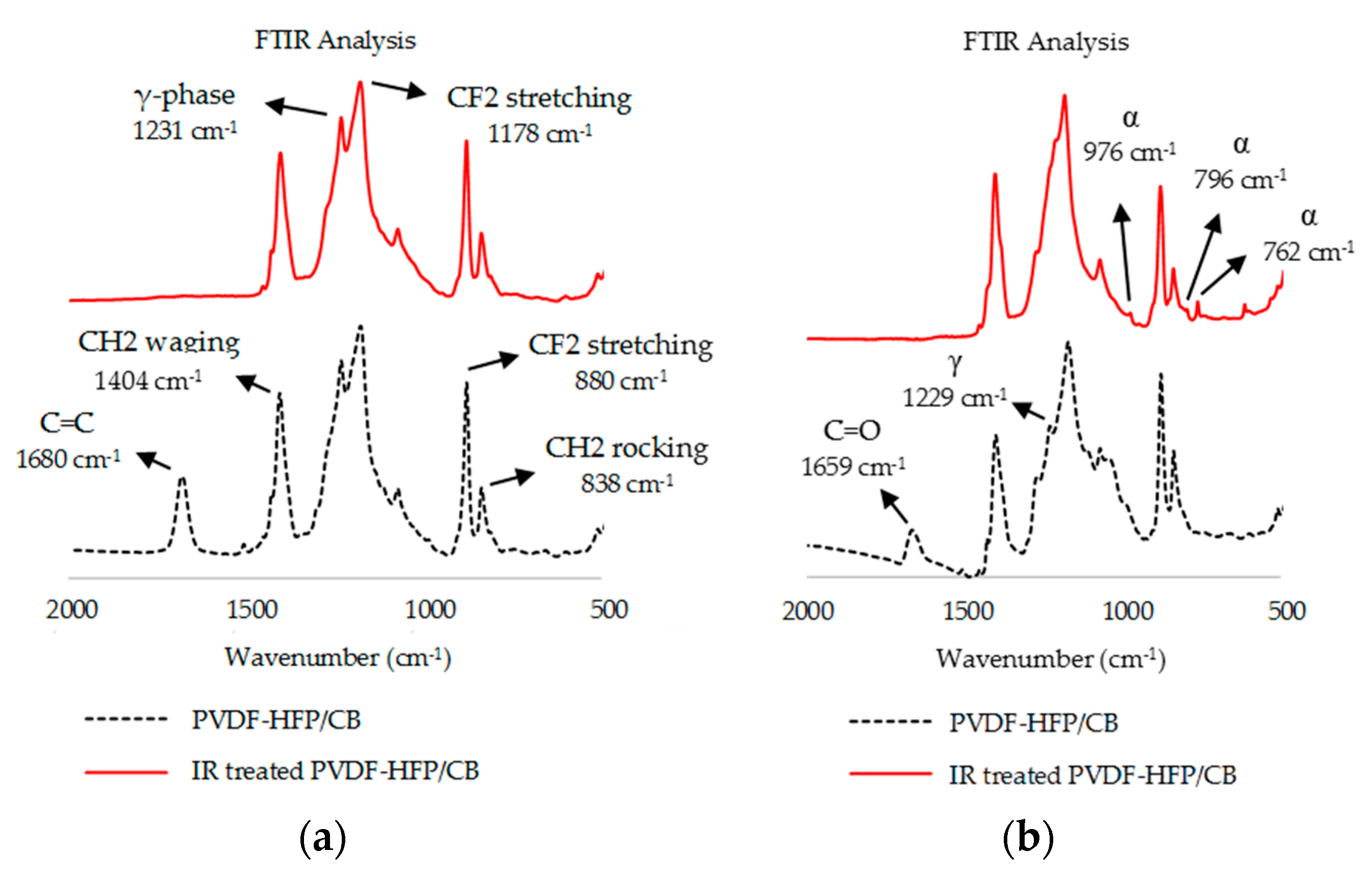
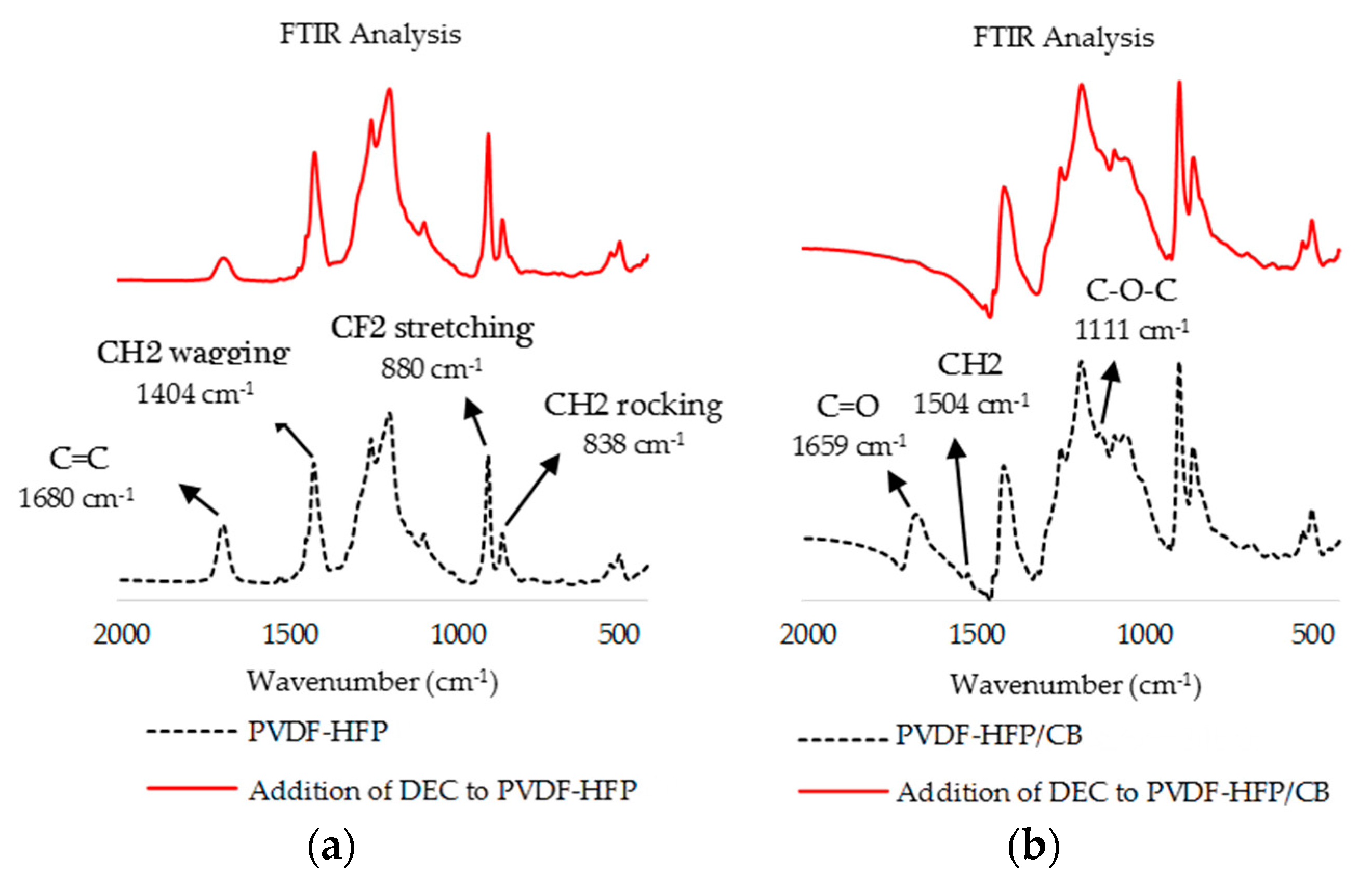
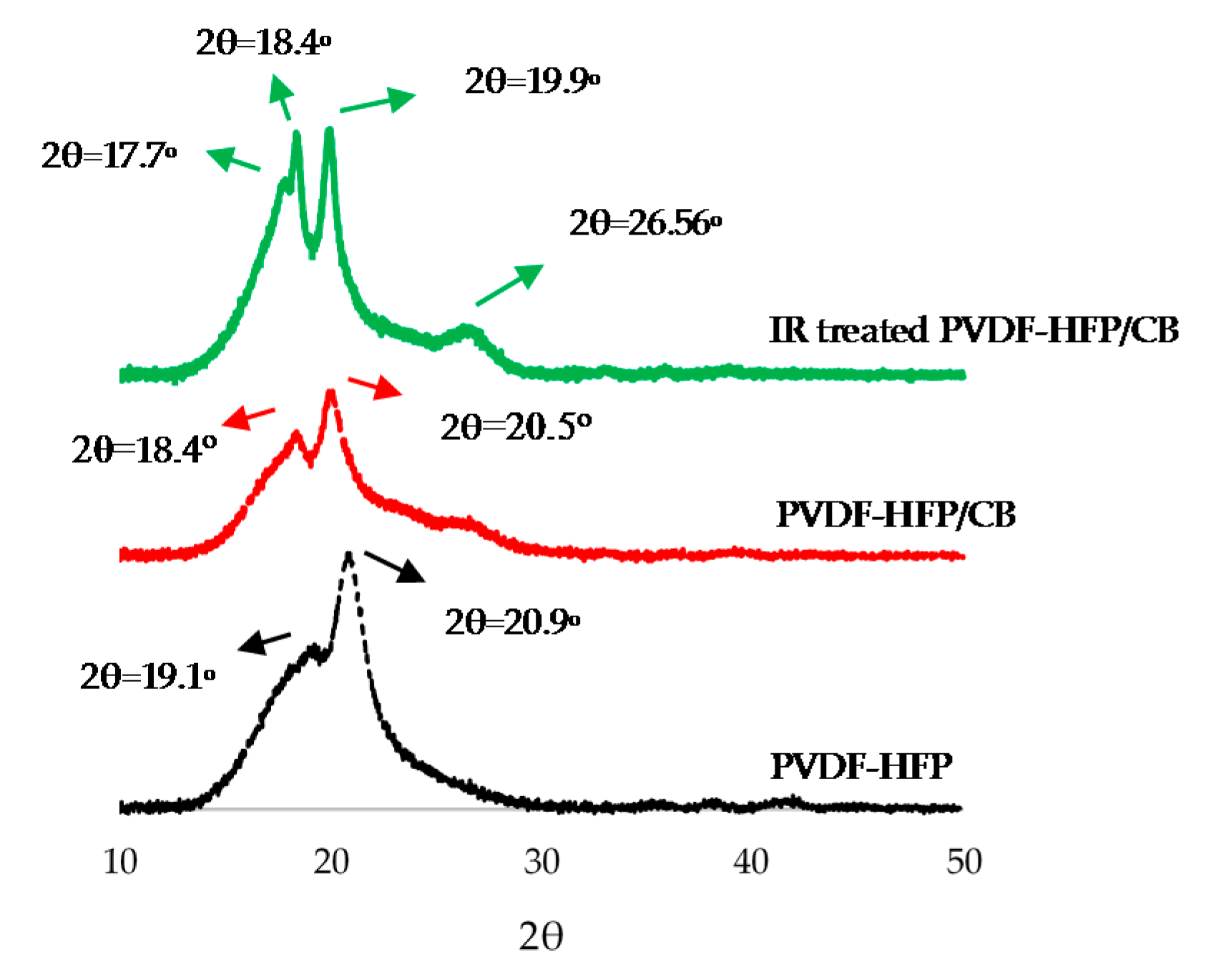
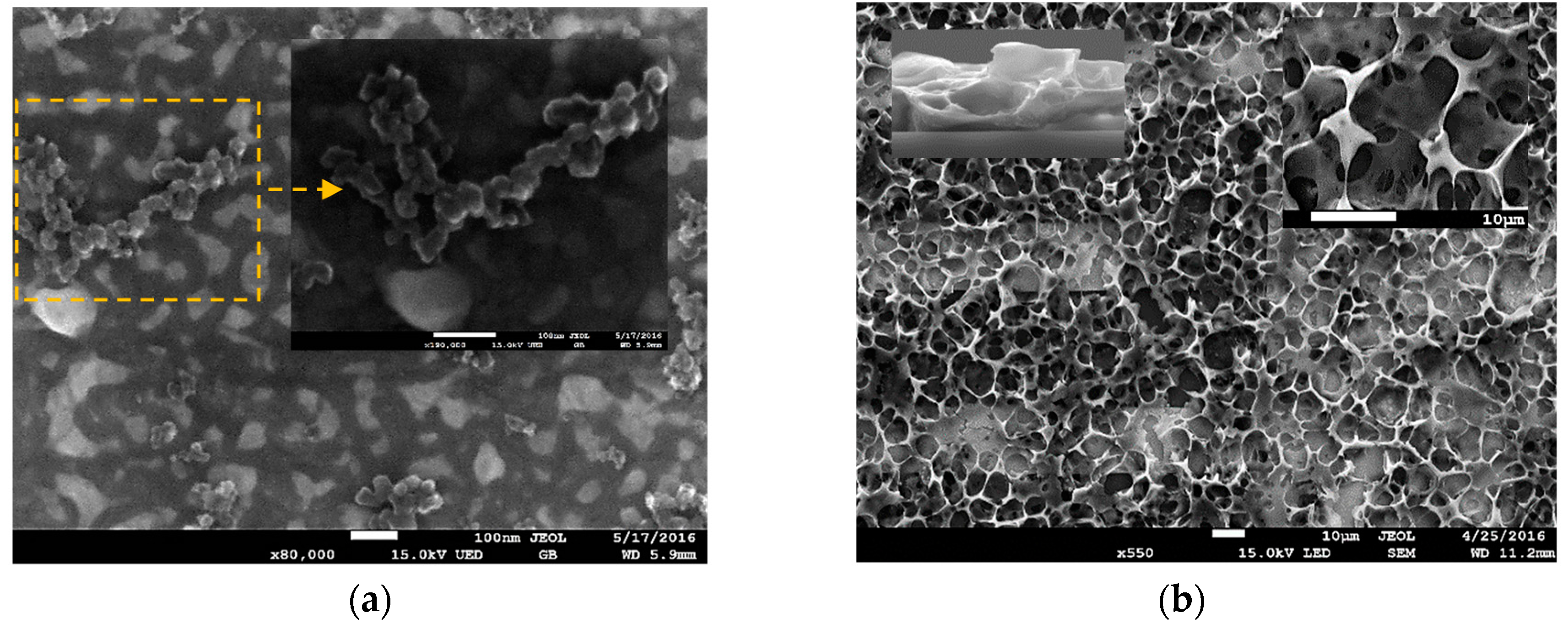
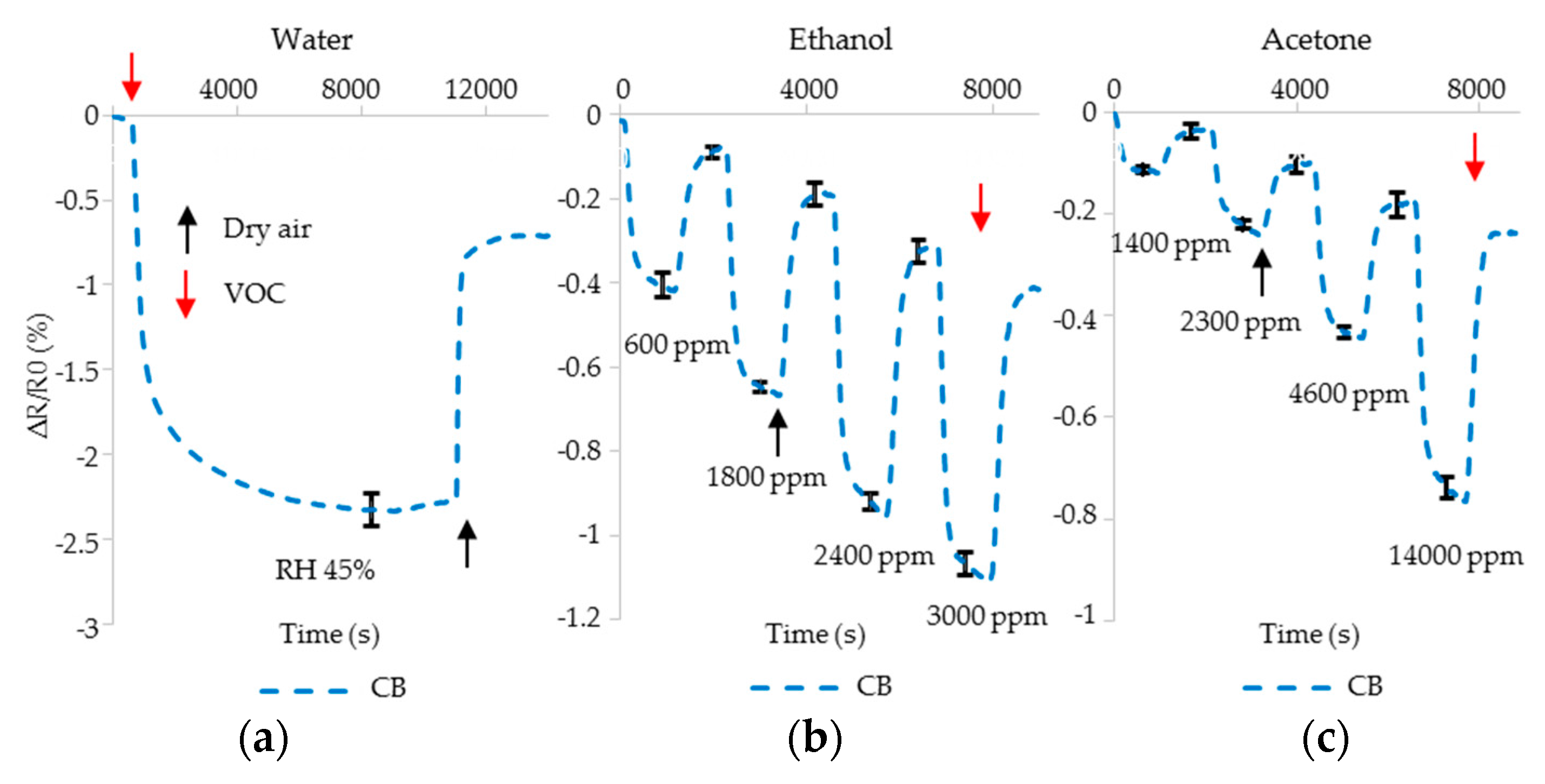
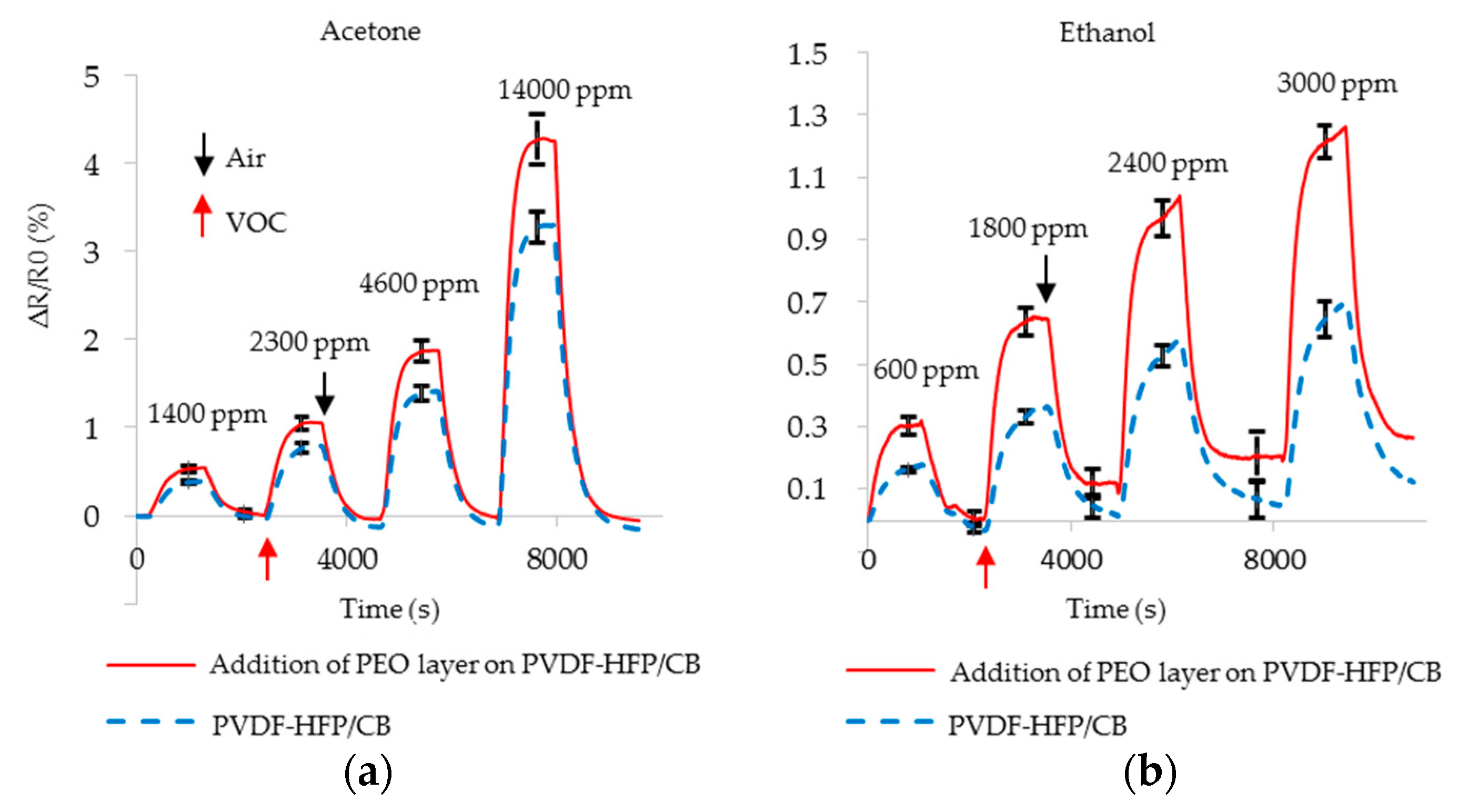

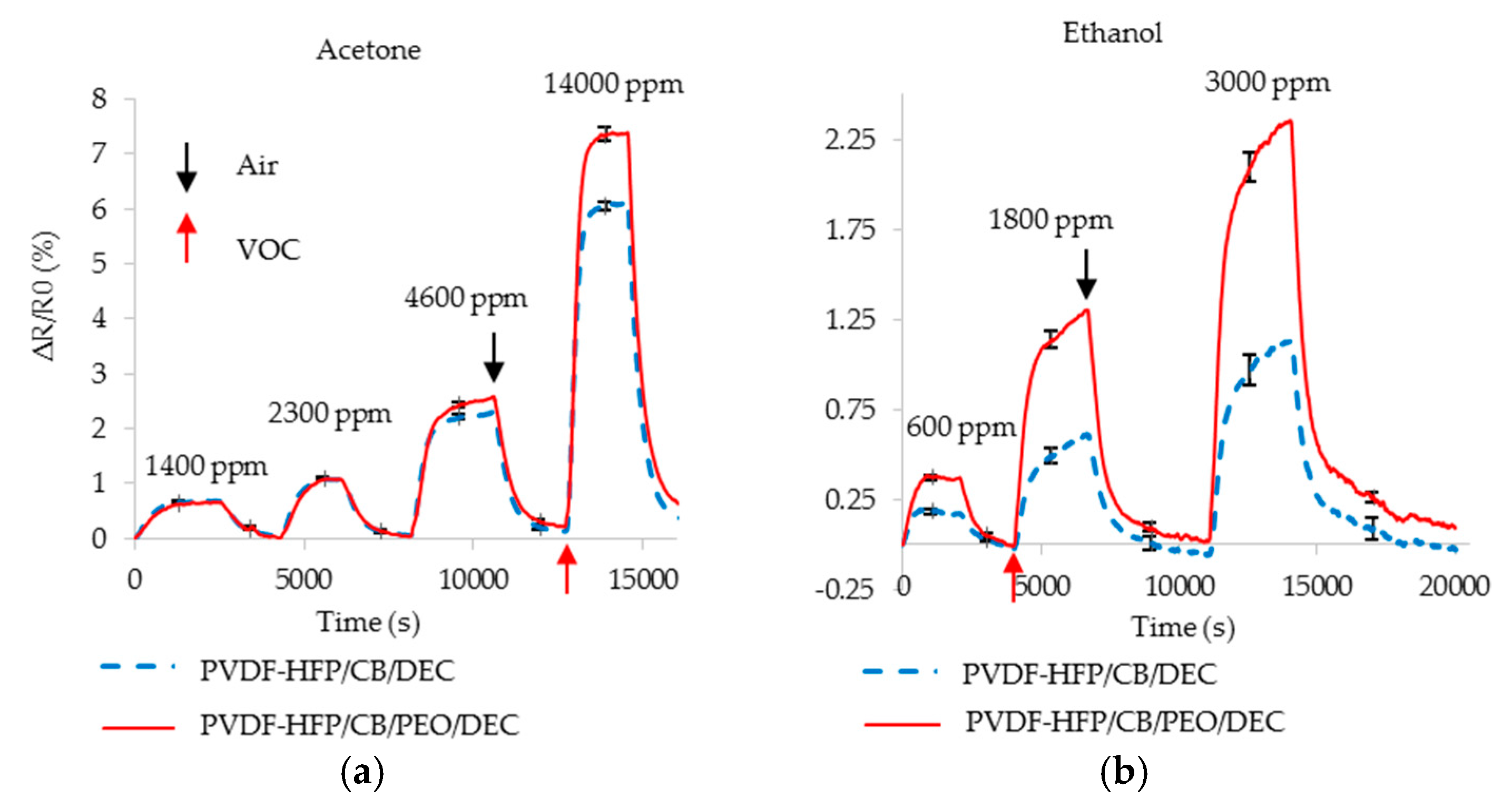
| Material | Acetone | Ethanol |
|---|---|---|
| Poly(4-vinylphenol)/CB | 4.2% (49,000 ppm) [24] | 2.3% (10,000 ppm) [24] |
| PMMA/f-CNT | 30% (55,000 ppm) * [25] | 1.7% (5000 ppm) * [26] |
| Iso-butyl methyl ketone/CNT | Not available | 1.25% (1000 ppm) [27] |
| PDLC/CNT | 4% (1800 ppm) * [28] | Not available |
| Network of CNT | 1% (3200 ppm) * [29] | 11.3% (77,000 ppm) * [30] |
| Network of oxidized CNT | 3.3% (3200 ppm) * [29] | 4.2% (5000 ppm) * [31] |
| Organic thiol capped GNP | 0.5% (500 ppm) * [13] | 1.15% (1500 ppm) [32] |
© 2017 by the authors. Licensee MDPI, Basel, Switzerland. This article is an open access article distributed under the terms and conditions of the Creative Commons Attribution (CC BY) license ( http://creativecommons.org/licenses/by/4.0/).
Share and Cite
Daneshkhah, A.; Shrestha, S.; Siegel, A.; Varahramyan, K.; Agarwal, M. Cross-Selectivity Enhancement of Poly(vinylidene fluoride-hexafluoropropylene)-Based Sensor Arrays for Detecting Acetone and Ethanol. Sensors 2017, 17, 595. https://doi.org/10.3390/s17030595
Daneshkhah A, Shrestha S, Siegel A, Varahramyan K, Agarwal M. Cross-Selectivity Enhancement of Poly(vinylidene fluoride-hexafluoropropylene)-Based Sensor Arrays for Detecting Acetone and Ethanol. Sensors. 2017; 17(3):595. https://doi.org/10.3390/s17030595
Chicago/Turabian StyleDaneshkhah, Ali, Sudhir Shrestha, Amanda Siegel, Kody Varahramyan, and Mangilal Agarwal. 2017. "Cross-Selectivity Enhancement of Poly(vinylidene fluoride-hexafluoropropylene)-Based Sensor Arrays for Detecting Acetone and Ethanol" Sensors 17, no. 3: 595. https://doi.org/10.3390/s17030595
APA StyleDaneshkhah, A., Shrestha, S., Siegel, A., Varahramyan, K., & Agarwal, M. (2017). Cross-Selectivity Enhancement of Poly(vinylidene fluoride-hexafluoropropylene)-Based Sensor Arrays for Detecting Acetone and Ethanol. Sensors, 17(3), 595. https://doi.org/10.3390/s17030595






